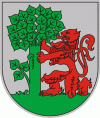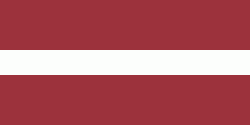Liepāja
 |
 |
In the 19th and early 20th century, it was a favourite place for sea-bathers and travellers, with the town boasting a fine park, many pretty gardens and a theatre. Liepāja is however known throughout Latvia as "City where the wind is born", likely because of the constant sea breeze. A song of the same name ("Pilsētā, kurā piedzimst vējš") was composed by Imants Kalniņš and has become the anthem of the city. Its reputation as the windiest city in Latvia was strengthened with the construction of the largest wind farm in the nation (33 Enercon wind turbines) nearby.
The coat of arms of Liepāja was adopted four days after the jurisdiction gained city rights on 18 March 1625. These are described as: "on a silver background, the lion of Courland with a divided tail, who leans upon a linden (Liepa) tree with its forelegs". The flag of Liepāja has the coat of arms in the center, with red in the top half and green in the bottom.
One of the very few surviving films documenting the mass murder of Jews during the first stages of the Holocaust is a short film by a German soldier who witnessed the massacre of Liepāja Jews in July 1941 near the city's lighthouse.
Liepāja is chosen as the European Capital of Culture in 2027.
The name was derived from the Livonian word Liiv meaning "sand". The oldest written text mentioning Līva village (Villa Liva) is the treaty of bishop of Courland and the Master of the Livonian Order dated 4 April 1253. In 1263, the Teutonic Order established a town which they called Libau in German and this was used until 1920. The Lettish name Liepāja was mentioned for the first time in 1649 by Paul Einhorn in his work Historia Lettica. A Russian name in Cyrillic from the time of the Russian Empire was Либава (Libava) or Либау (Libau), although Лиепая (Liepaya), a transliteration of Liepāja, has been used since World War II.
Some other names for the city include Liepoja in Lithuanian, the nearest neighbour, and Libow in English.
Map - Liepāja
Map
Country - Latvia
 |
 |
| Flag of Latvia | |
After centuries of Teutonic, Swedish, Polish-Lithuanian and Russian rule, which was mainly executed by the local Baltic German aristocracy, the independent Republic of Latvia was established on 18 November 1918 when it broke away from the German Empire and declared independence in the aftermath of World War I. However, by the 1930s the country became increasingly autocratic after the coup in 1934 establishing an authoritarian regime under Kārlis Ulmanis. The country's de facto independence was interrupted at the outset of World War II, beginning with Latvia's forcible incorporation into the Soviet Union, followed by the invasion and occupation by Nazi Germany in 1941, and the re-occupation by the Soviets in 1944 to form the Latvian SSR for the next 45 years. As a result of extensive immigration during the Soviet occupation, ethnic Russians became the most prominent minority in the country, now constituting nearly a quarter of the population. The peaceful Singing Revolution started in 1987, and ended with the restoration of de facto independence on 21 August 1991. Since then, Latvia has been a democratic unitary parliamentary republic.
Currency / Language
| ISO | Currency | Symbol | Significant figures |
|---|---|---|---|
| EUR | Euro | € | 2 |
| ISO | Language |
|---|---|
| LV | Latvian language |
| LT | Lithuanian language |
| RU | Russian language |















